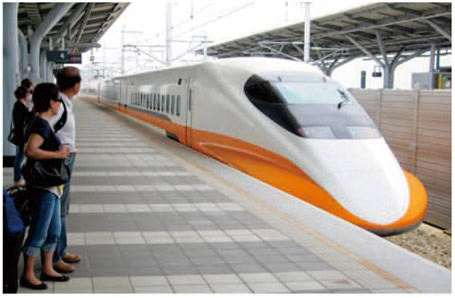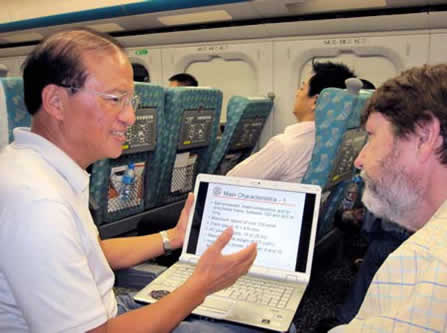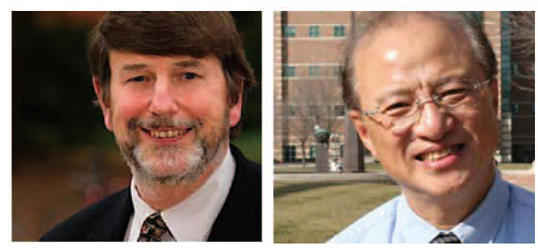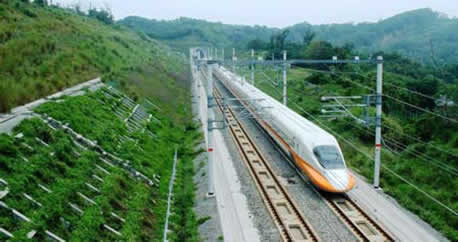特別報導 |
||||||||
High-Speed Rail a New Focus for Railroad Program Professor T.C. Kao, 高聰忠教授 伊利諾大學香檳分校軌道研究團隊將致力於高速鐵路研究
High-speed rail is the next big thing in railroad engineering in the United States, and the University of Illinois’ Railroad Engineering Program is assuming a leadership role in bringing the latest information about this hot topic to students, fellow educators, and the industry. This semester, an expert from Taiwan is teaching, at Illinois, the first university-level class in high-speed rail to be offered in the country. In addition, a major international rail conference will be held on the U of I campus in April, featuring high-speed and intercity passenger rail as its primary focus. High-speed passenger rail has been hailed as an energy-efficient, environmentally friendly mode of transportation. It requires a specialized system of dedicated tracks, trains built to travel at least 155 miles per hour, and advanced technology for support systems like communication and safety monitoring. Currently only one moderately high-speed line is in operation in the United States along the Northeast Corridor, but the Federal Railroad Administration has spent years outlining its vision for a network of true high-speed rail lines in the country, a plan that came closer to fruition with a funding pledge by the Obama administration. “Until the new administration’s commitment to high-speed rail, it was more of a distant hope than a likely reality to have extensive high-speed rail in this country,” says Professor Christopher P.L. Barkan, Krambles Faculty Fellow and Director of the Railroad Engineering Program. In January, President Obama pledged $8 billion toward the development of high-speed rail in the United States through the American Recovery and Reinvestment Act plus an additional $5 billion over five years through the annual budget process. Experts agree this is an important step but not nearly enough to develop a national high-speed rail network, the cost of which has been estimated at $100 billion. But whether the network takes decades to realize or gets a boost from private funding, high-speed rail will be part of the transportation picture in the U.S., and civil engineering students will benefit from knowledge of the field. 伊利諾大學香檳分校軌道工程研究團隊 Barkan教授特別提到:「直到歐巴馬政府作出興建美國高鐵的具體承諾後,高速鐵路網的形成才從一個遙不可及的夢想,成為可望實現的偉大成就。」今年一月,美國歐巴馬總統允諾將由振興經濟法案的專款基金中撥款八十億美元,並在未來五年的年度預算中再特別提撥五十億美元作為美國高鐵的經費來源。美國的其他專家也指出:「這樣的作法將有助於美國高鐵跨出第一步,但用來發展高速鐵路網還略顯不足,目前估算的經費將高達一千億美元。」無論這個路網得需要花上個數十年時間,也無法肯定有私人經費的挹注下,美國高鐵仍將會是未來美國運輸藍圖上絕對重要的一部份,而土木系的學生將佔有優勢的提早接觸這領域的一切了。 “There will be expanded opportunities for civil engineering students as a result of this initiative in the United States,” Barkan says. The high-speed rail course at Illinois owes its genesis to former Illinois student Yung-Cheng (Rex) Lai (MS 04, PhD 08), currently an assistant professor in the Department of Civil Engineering at National Taiwan University. Lai introduced Barkan to National Taiwan University colleague T.C. Kao, Ph.D., P.E., who teaches about high-speed rail and project management. Kao holds a bachelor’s degree from National Taiwan University in civil engineering, a master’s degree in structural engineering from Rutgers University, and both a master’s and a Ph.D. in geotechnical engineering from the University of California at Berkeley. He was a one-time student of former CEE faculty member Ralph Peck. Kao has spent his career working in railroad engineering and served as vice president of the Taiwan High-Speed Rail Corporation. In that capacity, he worked on all aspects of Taiwan’s high-speed rail project. Barkan and Kao began discussing the possibility of a high-speed rail class at Illinois, and Barkan saw the benefit of bringing Kao’s expertise to Illinois, particularly in the face of the country’s new momentum in high-speed rail.
“Professor Kao has excellent academic credentials, and when you combine that with a lifetime of experience working in the rail industry, it’s a rare blend,” Barkan says. “He has seen every single aspect of the planning, design, construction and operation of a high-speed rail system. And this is coming through very nicely in the class. The Taiwan system is one of the newest in the world, so he’s got a very current understanding of the state of the art of high-speed rail. I’ll also add that he’s a fantastic teacher.” Barkan教授說到:「高教授同時具備對高速鐵路的學術涵養與實務經驗,能夠從他身上學習,是極為難能可貴的機會。高教授先前參與的台灣高鐵計畫,也是當今世上最先進的高速鐵路系統,高教授在高速鐵路的瞭解非常徹底,舉凡規劃、設計、興建、營運等,這豐富的實務經驗將有幸在伊利諾大學香檳分校完整重現。特別是高教授在教學的認真態度,真是個了不起的教師。」
“The development of high-speed rail has pushed rail technology to new frontiers—the aerodynamic design of the train, the more powerful propulsion system, more energy-efficient braking system, the digital automatic train control system, the use of GSM [Global System for Mobile Communications] for data transmission, slab track which gives more track strength and stability with much less maintenance, disaster warning systems, innovative financial approaches,” Kao says. “And more technology development is under way. I think high-speed rail will bring a renaissance to passenger rail transportation in this country.” About 40 students are taking Kao’s course, which covers all aspects of a high-speed rail system from the technology behind it to operation and management, project planning, and project implementation.
The topic is of particular interest in the state of Illinois, which will receive some of the stimulus money for development of a high-speed rail line between Chicago and St. Louis. The near-term plan in Illinois, Barkan says, is to upgrade the existing rail line to allow a maximum speed of 110 miles per hour. To achieve considerably higher speed would require a brand new system with its own, dedicated right-of-way. It would cost much more but enable trains to travel at 220 miles per hour, providing a competitive alternative to driving or air travel, he says. According to Kao, Taiwan’s high-speed rail system transports 100,000 passengers a day—people who would otherwise travel by car or plane, resulting in a much larger carbon footprint. It’s a compelling idea for the United States and one whose time is coming quickly. “I think this country needs it,” says Kao. “This country needs high-speed rail.”
|



